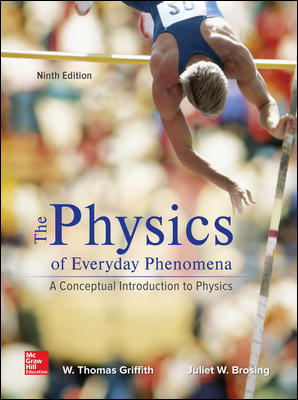Description
Test Bank For Physics of Everyday Phenomena 9Th edition By W, Thomas
The Physics of Everyday Phenomena, 9e (Griffith)
Chapter 2 Describing Motion
1) An auto, starting from rest, undergoes constant acceleration and covers a distance of 1250 meters. The final speed of the auto is 50 meters/sec. How long does it take the car to cover the 1250 meters?
A) 30 s
B) 50 s
C) 0.05 s
D) 72,000 s
Answer: B
Difficulty: 3 Hard
Topic: Uniform Acceleration
Chapter: 02 Describing Motion
Type: Numerical
Accessibility: Keyboard Navigation
2) A car traveling at constant speed
A) does not turn.
B) travels more distance in a second the longer the car travels.
C) can change direction.
D) cannot be going uphill.
Answer: C
Difficulty: 1 Easy
Topic: Average and Instantaneous Speed
Chapter: 02 Describing Motion
Type: Conceptual
Accessibility: Keyboard Navigation
3) An auto moves 10 meters in the first second of travel, 15 more meters in the next second, and 20 more meters during the third second. The acceleration of the auto is
A) 3.33 m/s2.
B) 9.8 m/s2.
C) 30 m/s2.
D) 5 m/s2.
E) zero m/s2.
Answer: D
Difficulty: 1 Easy
Topic: Acceleration
Chapter: 02 Describing Motion
Type: Conceptual
Accessibility: Keyboard Navigation
4) A quantity that is a measure of how the velocity of a body changes with time is
A) distance.
B) speed.
C) acceleration.
D) time.
Answer: C
Difficulty: 1 Easy
Topic: Acceleration
Chapter: 02 Describing Motion
Type: Conceptual; Definition
Accessibility: Keyboard Navigation
5) The following quantities relate to the rate of change of position. Which pair will always have the same magnitude?
A) Average speed and average velocity
B) Average speed and instantaneous speed
C) Average velocity and instantaneous velocity
D) Instantaneous speed and instantaneous velocity
Answer: D
Difficulty: 2 Medium
Topic: Average and Instantaneous Speed; Velocity
Chapter: 02 Describing Motion
Type: Conceptual
Accessibility: Keyboard Navigation
6) The acceleration of a body cannot be zero at a point where
A) the instantaneous velocity is zero.
B) the instantaneous velocity is positive but decreasing.
C) the average velocity is positive.
D) None of these choices are correct
Answer: B
Difficulty: 3 Hard
Topic: Acceleration
Chapter: 02 Describing Motion
Type: Conceptual
Accessibility: Keyboard Navigation
7) A student releases a ball from rest on an inclined plane and measures that it travels a distance of 0.8 m in a time of 4.0 s. The average speed of the ball is
A) 3.2 m/s.
B) 1.0 m/s.
C) 0.2 m/s.
D) 2.0 m/s.
Answer: C
Difficulty: 1 Easy
Topic: Average and Instantaneous Speed
Chapter: 02 Describing Motion
Type: Numerical
Accessibility: Keyboard Navigation
8) A student releases a ball from rest on an inclined plane and measures that it travels a distance of 0.5 m in a time of 2.0 s. The acceleration of the ball is
A) 0.125 m/s2.
B) 0.25 m/s2.
C) 0.5 m/s2.
D) 1.0 m/s2.
Answer: B
Difficulty: 1 Easy
Topic: Average and Instantaneous Speed; Acceleration
Chapter: 02 Describing Motion
Type: Numerical
Accessibility: Keyboard Navigation
9) A car travels a distance of 100 km. For the first 30 minutes it is driven at a constant speed of 80 km/hr. The motor begins to vibrate and the driver reduces the speed to 40 km/hr for the rest of the trip. The average speed for the entire trip is
A) 60.0 km/hr.
B) 53.3 km/hr.
C) 50.0 km/hr.
D) 47.5 km/hr.
E) 40.0 km/hr.
Answer: C
Difficulty: 3 Hard
Topic: Average and Instantaneous Speed
Chapter: 02 Describing Motion
Type: Numerical
Accessibility: Keyboard Navigation
10) Initially you are driving at 55 mi/hr. If you come to rest in 7.5 s while traveling 450 ft, what is your average speed while stopping? (There are 5280 ft in one mi.)
A) 55 mi/hr
B) 0.016 ft/s
C) 120 ft/s
D) 60 ft/s
Answer: D
Difficulty: 1 Easy
Topic: Average and Instantaneous Speed
Chapter: 02 Describing Motion
Type: Numerical
Accessibility: Keyboard Navigation
11) If your average speed for a 6 hr trip is 60 mi/hr, the distance traveled is
A) 10 mi.
B) 60 mi.
C) 120 mi.
D) 360 mi.
Answer: D
Difficulty: 1 Easy
Topic: Average and Instantaneous Speed
Chapter: 02 Describing Motion
Type: Numerical
Accessibility: Keyboard Navigation
12) You travel 2640 feet in thirty seconds while in a 65 mi/hr zone. (There are 5280 ft in one mi.) Your average speed is
A) larger than the speed limit.
B) exactly the speed limit.
C) less than the speed limit.
Answer: C
Difficulty: 1 Easy
Topic: Average and Instantaneous Speed
Chapter: 02 Describing Motion
Type: Numerical
Accessibility: Keyboard Navigation
13) In a speedometer test zone on a highway, you drive 4 miles in 5 minutes. During the test, your speedometer reading is 45 mi/hr. Your speedometer reading is
A) lower than your actual speed.
B) equal to your actual speed.
C) higher than your actual speed.
Answer: A
Difficulty: 1 Easy
Topic: Average and Instantaneous Speed
Chapter: 02 Describing Motion
Type: Numerical
Accessibility: Keyboard Navigation
14) Your car can accelerate at 8.0 m/s2, and there are 1609 m in one mile. So you can go from zero to 60 mi/hr in about
A) 3.35 s.
B) 2.74 s.
C) 1.34 s.
D) 0.37 s.
Answer: A
Difficulty: 2 Medium
Topic: Uniform Acceleration
Chapter: 02 Describing Motion
Type: Numerical
Accessibility: Keyboard Navigation
15) In order to go from rest to 50 m/s in 10 s, a jet must be able to accelerate at
A) 2 m/s2.
B) 5 m/s2.
C) 20 m/s2.
D) 50 m/s2.
Answer: B
Difficulty: 1 Easy
Topic: Uniform Acceleration
Chapter: 02 Describing Motion
Type: Numerical
Accessibility: Keyboard Navigation




Be the first to review “Test Bank For Physics of Everyday Phenomena 9Th edition By W,Thomas”